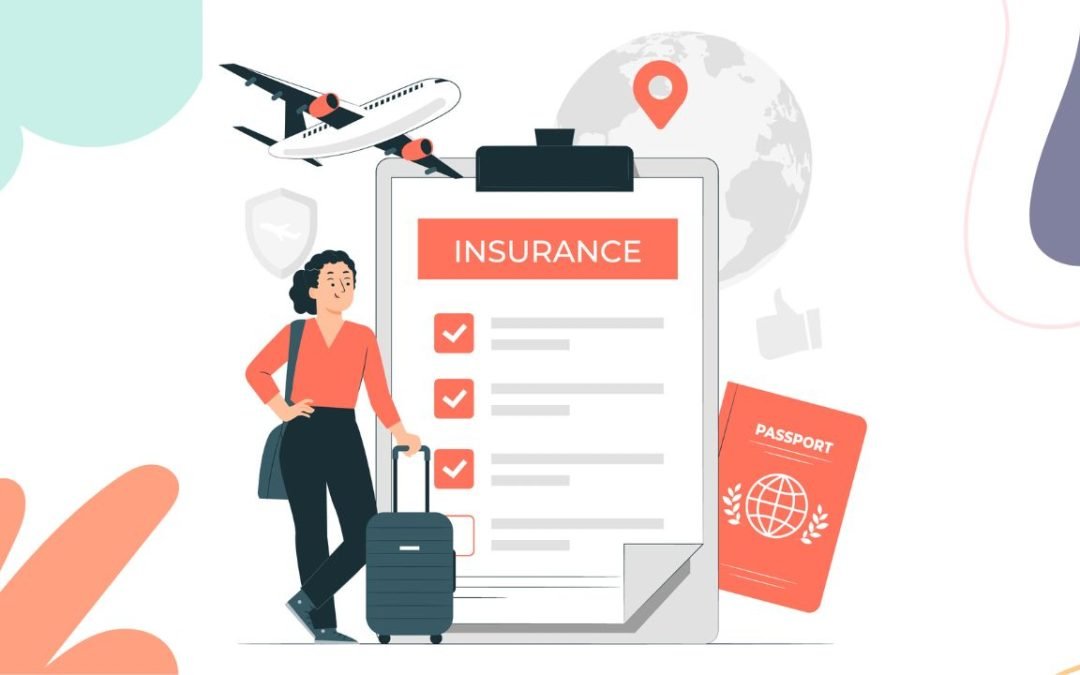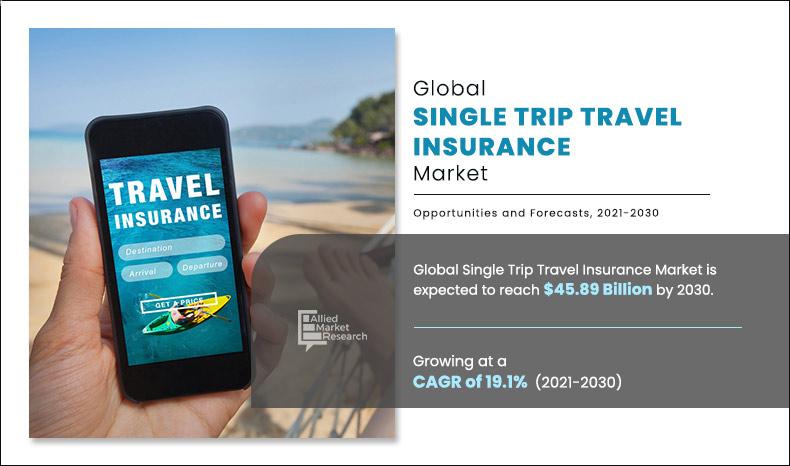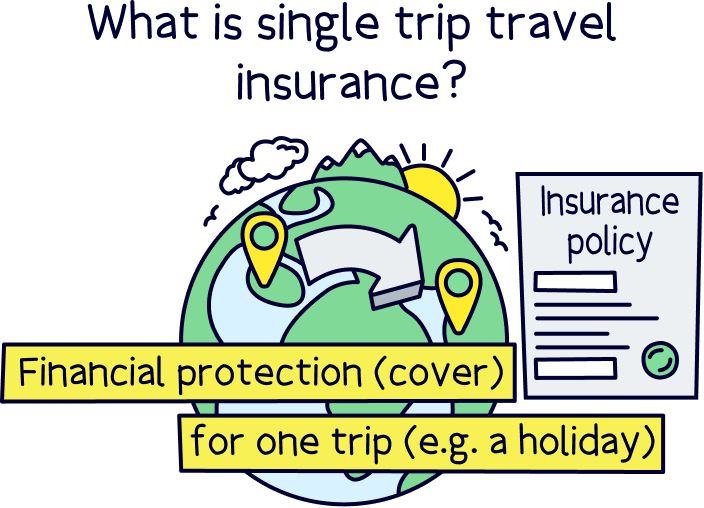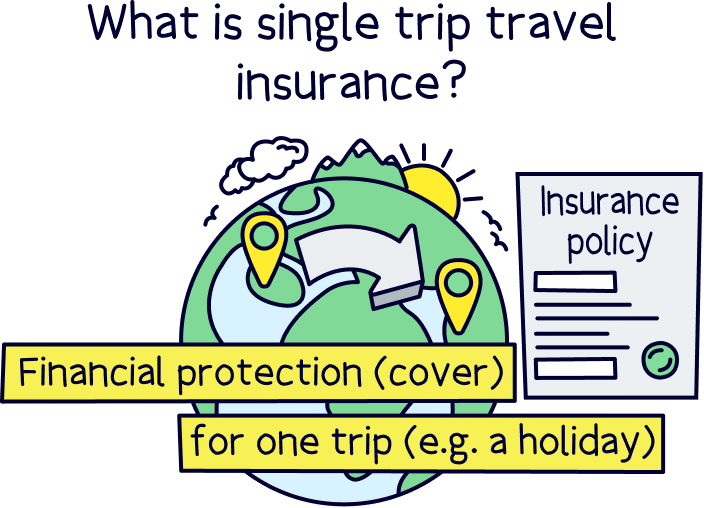Single trip travel insurance is a vital tool for any traveler. It provides a safety net for unexpected events, protecting your financial well-being during your journey. This comprehensive guide explores everything you need to know, from defining the insurance itself to understanding the claims process and choosing the right policy.
This resource will help you navigate the complexities of travel insurance, covering various aspects from coverage options to cost considerations. You’ll find valuable insights into comparing different policies, identifying crucial scenarios where insurance is necessary, and ultimately making informed decisions about your travel protection.
Defining Single Trip Travel Insurance

Single trip travel insurance provides financial protection for unforeseen events during a specific trip. It’s a valuable tool for mitigating potential risks and ensuring a smooth travel experience. This coverage is designed to address a range of circumstances, from medical emergencies to lost luggage.
Key Features and Benefits
Single trip travel insurance offers peace of mind by covering various potential issues. These policies typically include coverage for medical expenses, trip cancellations or interruptions, lost or damaged baggage, and personal liability. This comprehensive protection can significantly reduce financial strain in case of emergencies.
Types of Single Trip Travel Insurance
Different types of single trip travel insurance policies cater to varying needs. Medical insurance covers expenses related to illness or injury while traveling. Baggage insurance protects against loss or damage to personal belongings. Trip cancellation/interruption insurance provides reimbursement for pre-paid, non-refundable trip costs if the trip is canceled or interrupted due to unforeseen circumstances.
Common Exclusions and Limitations
Insurance policies often contain exclusions and limitations. Pre-existing medical conditions, certain activities (like extreme sports), and intentional acts are frequently excluded. Policy terms and conditions should be reviewed carefully for specific details. Travelers should also be aware of limitations on coverage amounts and geographical restrictions.
Comparison of Single Trip Travel Insurance Providers
A comparative analysis of different insurance providers can aid in selecting the most suitable coverage. The table below illustrates the typical coverage options offered by various providers.
| Insurance Provider | Medical Expenses (USD) | Baggage Loss/Damage (USD) | Trip Cancellation/Interruption (USD) | Personal Liability (USD) |
|---|---|---|---|---|
| Company A | 100,000 | 1,500 | 5,000 | 100,000 |
| Company B | 50,000 | 1,000 | 3,000 | 50,000 |
| Company C | 75,000 | 1,200 | 4,000 | 75,000 |
Note: Coverage amounts are examples and may vary depending on the specific policy and traveler’s needs. It’s crucial to review the full policy terms and conditions before purchasing.
Single trip travel insurance is a great way to protect yourself while on the go. It’s important to consider comprehensive coverage, like what you’d get with lv car insurance for your vehicle, if you’re planning a road trip as part of your journey. This ensures you’re covered for unexpected events, whether it’s a lost passport or a medical emergency, providing peace of mind during your travels.
Understanding the Need for Single Trip Travel Insurance

Protecting your trip, and yourself, is paramount when planning a journey. Single trip travel insurance provides a vital safety net, safeguarding you from unforeseen events that can disrupt your travel plans and potentially lead to significant financial burdens. This coverage offers peace of mind, allowing you to fully immerse yourself in your travel experience without constant worry.
Crucial Scenarios for Single Trip Insurance
Single trip insurance is indispensable in various situations, mitigating risks that can significantly impact your trip. Emergencies, such as medical evacuations, lost luggage, or trip cancellations due to unforeseen circumstances, can quickly deplete your funds and ruin your travel experience. Insurance acts as a financial cushion, covering these potential pitfalls.
Importance of Comprehensive Travel Insurance
Comprehensive single trip insurance goes beyond basic coverages. It typically includes medical expenses, trip cancellations, baggage loss, and other potential disruptions. A comprehensive policy offers broad protection, ensuring that your financial resources are safeguarded in a wide range of scenarios. The breadth of coverage is a crucial factor to consider when evaluating the importance of such insurance.
Risks Mitigated by Single Trip Insurance
Travel carries inherent risks. Single trip insurance helps mitigate these risks by providing financial protection against various unforeseen circumstances. These risks include medical emergencies abroad, lost or damaged baggage, trip cancellations due to unforeseen circumstances, and delays. Insurance can offset the financial burden associated with these events, ensuring a smoother and more manageable travel experience.
Financial Implications of Not Having Insurance
The absence of travel insurance can lead to substantial financial losses during a trip. Unexpected medical expenses, lost or damaged luggage, and trip cancellations can easily drain your savings and create significant financial stress. The potential for significant out-of-pocket expenses can easily become overwhelming, and without insurance, you may be left with a considerable financial burden.
Examples of Beneficial Situations
Consider a scenario where a traveler experiences a sudden illness during a trip requiring immediate medical attention. Without insurance, the cost of medical treatment could be substantial. Insurance steps in to cover these expenses, ensuring the traveler receives the necessary care without jeopardizing their finances. Another example includes a traveler whose luggage is lost or damaged during transit. Insurance compensates for the value of lost or damaged belongings, mitigating the financial impact of this unforeseen event.
Table: Travel Scenarios and Insurance Usefulness
| Travel Scenario | How Single Trip Insurance Can Be Useful |
|---|---|
| Medical Emergency Abroad | Covers medical expenses, including emergency evacuation, potentially saving a considerable amount of money. |
| Lost or Damaged Luggage | Replaces lost or damaged items, preventing significant financial loss due to lost belongings. |
| Trip Cancellation Due to Weather Events | Reimburses non-refundable costs associated with the trip cancellation. |
| Natural Disasters Affecting Destination | Covers trip interruptions or cancellations due to unforeseen natural disasters. |
| Pre-existing medical conditions requiring treatment | Covers pre-existing medical conditions that may require treatment during the trip, mitigating potential costs. |
Comparing Single Trip Insurance with Other Options
Single trip travel insurance provides specific coverage for a single journey. Understanding its distinctions from other options, like multi-trip insurance, is crucial for making informed decisions. This section will delve into the nuances of single trip coverage, highlighting its advantages and disadvantages, and comparing it with other travel-related protection.
Comparison with Multi-Trip Travel Insurance
Multi-trip travel insurance provides comprehensive coverage for multiple trips within a defined period, offering cost savings compared to purchasing individual single trip policies. However, single trip insurance is tailored to a specific journey, offering flexibility for trips of varying durations and destinations. Single trip policies often have lower premiums for shorter trips, making them more economical for occasional travelers.
Advantages of Single Trip Insurance
Single trip insurance excels in its tailored approach. It offers a focused solution for a single travel event, often with lower premiums compared to multi-trip policies. This makes it particularly attractive for those undertaking a single, specific trip.
- Lower premiums: Single trip insurance usually has a lower premium structure than multi-trip coverage, especially for shorter trips.
- Flexibility: It provides the freedom to purchase insurance only when needed, tailored to a specific trip’s duration and destination.
- Cost-effectiveness: The focused coverage often results in more affordable premiums compared to multi-trip plans, making it an economical option for infrequent travelers.
Disadvantages of Single Trip Insurance
While advantageous in many situations, single trip insurance has certain drawbacks. It offers coverage only for a single trip, requiring a new purchase for each new adventure.
- Limited coverage period: Single trip insurance is valid only for the specific trip dates, providing no ongoing protection beyond that timeframe.
- No ongoing protection: Unlike multi-trip coverage, single trip insurance does not offer continuous protection for multiple travels.
- Cost for multiple trips: Purchasing separate single trip policies for multiple trips over a short period can lead to higher overall costs compared to a single multi-trip policy.
Impact of Trip Duration on Suitability
The duration of a trip plays a crucial role in the suitability of single trip insurance. Shorter trips often benefit from the lower premiums of single trip policies, while longer trips might be better suited for multi-trip plans to cover potential extended issues.
Comparison Table
| Feature | Single Trip Insurance | Multi-Trip Insurance | Other Travel Protection Options (e.g., credit card travel insurance) |
|---|---|---|---|
| Coverage Period | Specific trip dates | Defined period (e.g., one year) | Varies based on the card and policy |
| Premium | Generally lower for shorter trips | Often lower per trip, but potentially higher initial premium | Often included as a perk of a credit card; varies in coverage |
| Flexibility | Flexible for individual trips | Provides ongoing protection | Often tied to credit card usage |
| Cost-effectiveness | Economical for occasional travelers | More cost-effective for frequent travelers | May or may not be cost-effective depending on the card and trip details |
Factors Influencing Single Trip Insurance Costs

Single trip travel insurance premiums are not fixed; they are dynamic and depend on a multitude of factors. Understanding these factors is crucial for travelers to make informed decisions and potentially secure more affordable coverage. A comprehensive understanding allows for better budgeting and reduces the likelihood of being caught off guard by unexpected expenses.
Destination Risk Assessment
Travel destinations vary significantly in terms of safety, security, and potential medical emergencies. High-risk areas, often characterized by political instability, natural disasters, or widespread disease outbreaks, will naturally command higher insurance premiums. Similarly, destinations with limited access to medical facilities or requiring specialized vaccinations may also increase the cost. For instance, a trip to a remote region with limited medical infrastructure will likely have a higher premium compared to a trip to a well-developed city.
Trip Duration and Coverage Scope
The longer the trip duration, the greater the potential exposure to unforeseen circumstances, consequently impacting the insurance premium. A longer trip increases the probability of medical issues, lost luggage, or trip cancellations, all of which are covered under travel insurance. The scope of coverage also plays a role. Policies with broader coverage, encompassing more potential risks, tend to have higher premiums. A trip encompassing a series of high-risk activities like mountaineering or white-water rafting would be significantly more expensive than a trip focused on sightseeing.
Traveler Profiles and Pre-existing Conditions
Traveler profiles significantly influence the cost of single trip travel insurance. Factors like age, health status, and pre-existing medical conditions are vital considerations for insurance providers. Older travelers and those with pre-existing conditions are typically assessed as higher risk, leading to higher premiums. Insurance providers adjust the price based on the predicted risk associated with these profiles. Furthermore, travelers with pre-existing conditions might be required to disclose these conditions to the insurer for accurate risk assessment.
Travel Insurance Provider Policies and Coverage Levels
Travel insurance providers operate with varying policies and coverage levels. Policies with comprehensive coverage, including wider contingencies like trip cancellations, lost luggage, and medical emergencies, usually have higher premiums. Different providers also use different criteria for calculating risk and pricing. Policies with limited coverage or excluding specific risks, on the other hand, may have lower premiums. For example, policies that exclude coverage for pre-existing conditions will typically be cheaper than those that include them.
Methods for Reducing Single Trip Insurance Costs
Travelers can take several steps to potentially lower the cost of their single trip travel insurance. These include carefully selecting the appropriate level of coverage, choosing a travel insurance provider offering competitive rates, and being aware of any discounts or bundled offers available. Evaluating the coverage offered by various providers is also essential for comparison.
Impact of Factors on Single Trip Insurance Prices
| Factor | Impact on Price | Example |
|---|---|---|
| Destination Risk | Higher risk destinations lead to higher premiums | A trip to a war-torn country vs. a trip to a peaceful European country |
| Trip Duration | Longer trips typically result in higher premiums | A two-week trip vs. a weekend getaway |
| Traveler Profile | Older travelers or those with pre-existing conditions may pay more | A young, healthy traveler vs. a senior with a pre-existing heart condition |
| Coverage Level | More comprehensive coverage often means higher premiums | A policy covering trip cancellations and medical emergencies vs. one with limited coverage |
| Provider Policy | Different providers have different pricing strategies | Comparing quotes from multiple providers |
Claims Process and Procedures

Navigating the claims process can be a crucial aspect of your travel insurance experience. Understanding the steps involved and the required documentation can significantly streamline the process and expedite your claim resolution. This section Artikels the typical claims process, providing a comprehensive guide to filing a claim successfully.
Typical Claims Process
The claims process for single-trip travel insurance typically involves several steps, from initial notification to final settlement. A well-defined process ensures a smooth and efficient resolution of your claim. The exact procedures may vary slightly between insurance providers, but the core elements remain consistent.
Steps Involved in Filing a Claim
A well-organized approach to filing a claim is essential. Following these steps ensures your claim is processed efficiently:
- Initial Notification: Contact your insurance provider immediately after the covered incident occurs. Provide details about the incident, including the date, time, and location. The earlier you report, the better. For example, if your luggage is lost at the airport, contact your insurance company right away.
- Gathering Documentation: Collect all necessary supporting documents. This often includes the incident report, receipts, medical bills, and any other relevant paperwork. Thorough documentation is key for a smooth claim process.
- Submitting Claim Form: Complete the claim form provided by your insurance company accurately and completely. Ensure all requested information is provided to avoid delays. Incorrect or incomplete forms can delay the processing time.
- Claim Review: The insurance company will review your claim and supporting documents. This process may involve contacting witnesses or further investigation.
- Settlement or Denial: Depending on the claim’s validity, the insurance company will either approve the claim or deny it. Reasons for denial are often detailed in writing.
Required Documentation for a Successful Claim
Proper documentation is crucial for a successful claim. Here’s a summary of the common documents needed:
- Trip Itinerary and Confirmation: Proof of the trip, including flight tickets and hotel bookings, helps validate the trip dates.
- Police Report (if applicable): In cases of theft or crime, a police report is often required to substantiate the claim.
- Medical Records (if applicable): For medical expenses, copies of medical records, receipts, and doctor’s notes are vital.
- Receipts and Invoices: Records of expenses incurred, such as lost luggage items, medical treatment, or accommodation costs, are essential.
- Other Supporting Documents: Any additional documents relevant to the claim, such as witness statements or photographs, should be provided.
Typical Timeframe for Claim Processing
Claim processing timeframes vary significantly based on the complexity of the claim and the insurance provider. A standard claim might be processed within a few weeks, while more complex cases may take longer. For example, a straightforward lost baggage claim might be settled within 4-6 weeks, while a complicated medical claim could take 8-12 weeks.
How to Contact the Insurance Provider for Assistance
Contacting your insurance provider for assistance is straightforward. You can typically reach them via phone, email, or online portal. Detailed contact information is usually provided in your policy documents. For example, you can find the contact details on your insurance policy’s welcome letter.
Step-by-Step Guide for Filing a Claim
| Step | Action |
|---|---|
| 1 | Report the incident to the insurance company immediately. |
| 2 | Gather all necessary documentation (e.g., receipts, medical bills, police reports). |
| 3 | Complete the claim form accurately. |
| 4 | Submit the claim form and supporting documents to the insurance provider. |
| 5 | Follow up with the insurance provider regarding the status of the claim. |
Choosing the Right Single Trip Insurance
Securing the right travel insurance policy is crucial for a smooth and worry-free trip. It’s essential to understand that one size doesn’t fit all, and a tailored approach is needed to best protect your interests. A comprehensive understanding of the available options is key to making an informed decision.
Comparing Policies from Different Providers
A critical aspect of securing the right insurance is comparing policies from various providers. This comparative analysis allows you to assess coverage, exclusions, and pricing to find the best fit for your needs. By examining different policies, you can identify gaps in coverage or areas where one provider offers superior protection at a more competitive price. This process is essential for maximizing your financial protection and minimizing potential risks.
Factors to Consider When Evaluating Policies
Several key factors influence the suitability of a single trip insurance policy. Coverage for medical emergencies, lost luggage, trip cancellations, and other unforeseen circumstances should be evaluated carefully. The policy’s excess (deductible) amount, the maximum payout, and any limitations on the type of activities covered are important considerations. The geographical coverage area and the duration of the trip are also crucial factors in choosing the most suitable policy. Additionally, consider the provider’s reputation, financial stability, and customer service track record. These factors contribute to a well-rounded assessment of the policy’s overall value.
Understanding Policy Terms and Conditions
Thorough review of the policy’s terms and conditions is paramount. This involves carefully examining the definitions of covered and excluded events, the claims process, and any limitations or exclusions. It is vital to understand the specifics of the policy’s limitations, including geographical restrictions, activity restrictions, and exclusions for pre-existing medical conditions. This comprehensive understanding empowers you to make an informed choice and avoid surprises later on.
Questions to Ask Travel Insurance Providers
Before purchasing a policy, a series of crucial questions should be posed to the provider. These inquiries should focus on the specific coverage details and the provider’s commitment to handling claims efficiently. For example, inquiries about the maximum payout amount, the claims process, and the policy’s cancellation terms are essential. Clarifying the exclusions for pre-existing conditions, specific activities, or locations is also crucial. Understanding the provider’s customer service capabilities and handling of disputes is equally important.
Finding Reputable Providers
Choosing a reputable travel insurance provider is vital for ensuring a smooth claim process and trustworthy service. Look for providers with a strong online presence, positive customer reviews, and a history of timely and fair claims settlement. Seek recommendations from trusted sources, such as friends, family, or travel forums. Investigate the provider’s financial stability and accreditation, as these factors provide assurance of their commitment to fulfilling their contractual obligations. The provider’s reputation for fair dealing and prompt service should be prioritized.
Example Policy Comparison Table
| Provider | Features | Pricing (USD) |
|---|---|---|
| Company A | Comprehensive coverage, 24/7 emergency assistance, cancellation/interruption protection, lost/delayed baggage, medical expenses | $150 |
| Company B | Excellent medical coverage, robust cancellation protection, limited baggage coverage | $120 |
| Company C | Focus on adventure sports, high medical coverage limits, comprehensive cancellation | $180 |
This table provides a basic example. Pricing and features can vary significantly based on individual needs and the specific trip details. Always consult the provider’s website for the most up-to-date information.
Illustrative Case Studies
Single trip travel insurance provides crucial financial protection against unforeseen circumstances during travel. Understanding how this insurance can mitigate potential losses is vital for informed decision-making. Illustrative case studies offer valuable insights into the real-world benefits of travel insurance.
Case studies demonstrate how single trip insurance can be a lifeline for travelers facing unexpected challenges. These accounts highlight the importance of comprehensive coverage and the role of prompt claims processing in securing financial recovery.
Examples of Successful Claims
Travel insurance policies offer a safety net, protecting travelers from financial hardship due to unforeseen events. A variety of situations can lead to significant expenses, and having travel insurance can significantly reduce these burdens.
- A family traveling to Europe experienced a sudden illness of a child requiring immediate medical attention in a foreign country. The comprehensive medical coverage within their travel insurance policy covered the substantial medical expenses, ensuring the family’s financial well-being and facilitating their prompt return home.
- A solo traveler, while on a hiking trip in the Himalayas, sustained a severe ankle injury requiring hospitalization and subsequent rehabilitation. The single trip travel insurance policy paid for the necessary medical care and provided travel assistance to arrange for the traveler’s return, preventing significant financial loss and ensuring a swift recovery.
- A group of friends on a cruise vacation encountered a severe storm that damaged their ship, leading to delays and disruption of their itinerary. Their travel insurance covered the cost of alternative accommodations and transportation, helping them recover from the disruption and avoid significant financial losses.
Financial Protection from Trip Cancellations
Unexpected circumstances can lead to trip cancellations, causing substantial financial losses. Travel insurance can mitigate these losses.
- A business traveler booked a flight and hotel for a critical conference. Due to a sudden, severe illness, they were unable to attend. Their travel insurance policy covered the non-refundable flight and hotel costs, preventing a significant financial loss and allowing them to recover from the illness without financial worry.
- A family planned a summer vacation. Due to unforeseen circumstances, such as a family emergency, they had to cancel their trip. Their travel insurance policy covered the non-refundable costs of their hotel and airfare, providing financial relief during a challenging time.
Assistance During Unexpected Events
Travel insurance policies can provide support and guidance during unexpected events, ensuring a smooth recovery process.
- A traveler lost their passport while in a foreign country. The travel insurance policy facilitated the issuance of a replacement passport and assisted with repatriation, minimizing stress and inconvenience.
- A traveler experienced significant luggage loss during their trip. The travel insurance policy provided coverage for the replacement of lost belongings, mitigating the financial impact of the loss and ensuring the traveler could continue their trip without undue hardship.
“Our family’s trip to Italy was severely disrupted by a sudden illness of our daughter. Without the comprehensive medical coverage of our single trip travel insurance policy, we would have faced insurmountable medical costs and lost a significant portion of our vacation funds. The policy covered the entire medical expense, allowing us to focus on our daughter’s recovery and return home without any financial worries. We highly recommend having travel insurance for any trip.”
Outcome Summary

In conclusion, securing single trip travel insurance is a smart move for any traveler. It offers peace of mind, financial protection, and a way to navigate the potential risks associated with travel. By understanding the different types of coverage, the factors affecting costs, and the claims process, you can make an informed choice to ensure a smooth and worry-free trip. This guide has provided a comprehensive overview, allowing you to confidently plan your next adventure.
Single trip travel insurance is crucial for peace of mind when you’re travelling. It’s a good idea to explore options like NTUC Income travel insurance, which offers a range of comprehensive coverage for various scenarios. Looking at plans available via NTUC Income ntuc income travel insurance can help you find the perfect fit for your needs, ensuring your trip goes smoothly and without financial worries.
Ultimately, securing appropriate single trip travel insurance is key for a stress-free journey.
Single trip travel insurance is a great way to protect yourself while abroad. It’s important to consider comprehensive coverage, and you might also want to look into Sainsbury’s car insurance options, if you plan to travel with a vehicle. Ultimately, careful comparison of various policies is key when choosing single trip travel insurance.

